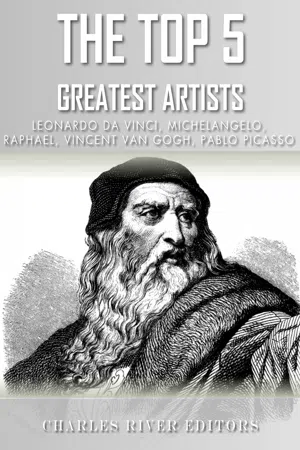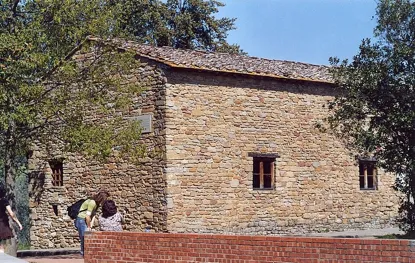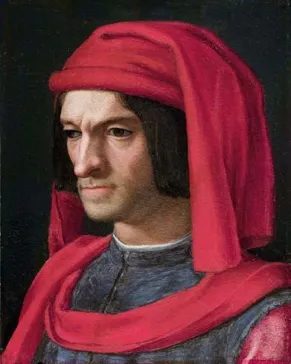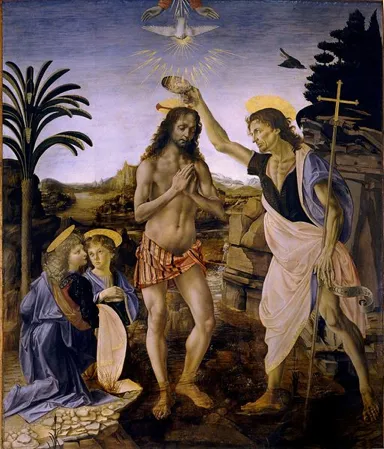
eBook - ePub
The Top 5 Greatest Artists
Leonardo, Michelangelo, Raphael, Vincent Van Gogh, and Pablo Picasso
- English
- ePUB (mobile friendly)
- Available on iOS & Android
eBook - ePub
The Top 5 Greatest Artists
Leonardo, Michelangelo, Raphael, Vincent Van Gogh, and Pablo Picasso
About this book
The Top 5 Greatest Artists is a collection of biographies onLeonardo, Michelangelo, Raphael, Vincent Van Gogh, and Pablo Picasso.
Frequently asked questions
Yes, you can cancel anytime from the Subscription tab in your account settings on the Perlego website. Your subscription will stay active until the end of your current billing period. Learn how to cancel your subscription.
At the moment all of our mobile-responsive ePub books are available to download via the app. Most of our PDFs are also available to download and we're working on making the final remaining ones downloadable now. Learn more here.
Perlego offers two plans: Essential and Complete
- Essential is ideal for learners and professionals who enjoy exploring a wide range of subjects. Access the Essential Library with 800,000+ trusted titles and best-sellers across business, personal growth, and the humanities. Includes unlimited reading time and Standard Read Aloud voice.
- Complete: Perfect for advanced learners and researchers needing full, unrestricted access. Unlock 1.4M+ books across hundreds of subjects, including academic and specialized titles. The Complete Plan also includes advanced features like Premium Read Aloud and Research Assistant.
We are an online textbook subscription service, where you can get access to an entire online library for less than the price of a single book per month. With over 1 million books across 1000+ topics, we’ve got you covered! Learn more here.
Look out for the read-aloud symbol on your next book to see if you can listen to it. The read-aloud tool reads text aloud for you, highlighting the text as it is being read. You can pause it, speed it up and slow it down. Learn more here.
Yes! You can use the Perlego app on both iOS or Android devices to read anytime, anywhere — even offline. Perfect for commutes or when you’re on the go.
Please note we cannot support devices running on iOS 13 and Android 7 or earlier. Learn more about using the app.
Please note we cannot support devices running on iOS 13 and Android 7 or earlier. Learn more about using the app.
Yes, you can access The Top 5 Greatest Artists by Charles River Editors in PDF and/or ePUB format, as well as other popular books in Art & Artist Biographies. We have over one million books available in our catalogue for you to explore.
Information
Topic
ArtSubtopic
Artist BiographiesChapter 1: Leonardo's Childhood
“Seeing that I can find no subject specially useful or pleasing— since the men who have come before me have taken for their own every useful or necessary theme— I must do like one who, being poor, comes last to the fair, and can find no other way of providing himself than by taking all the things already seen by other buyers, and not taken but refused by reason of their lesser value. I, then, will load my humble pack with this despised and rejected merchandise, the refuse of so many buyers; and will go about to distribute it, not indeed in great cities, but in the poorer towns, taking such a price as the wares I offer may be worth.” – The Notebooks of Leonardo da Vinci

Leonardo’s childhood home in Anchiano
On April 15, 1452, Lionardo di ser Piero da Vinci was born out of wedlock in or around Vinci, Italy to a relatively wealthy local notary, Ser Piero, and a young peasant woman, Caterina. Though nobody knew what the child would become, Ser Piero’s father Antonio noted the birth and baptism in his daily journal.
While little is known about his early childhood, Leonardo likely remained with his mother for at least his first year of life and may have spent his first several years with her. Leonardo’s mother, Caterina, eventually married another man and moved away from the area, at which point Leonardo may have been taken in by his paternal family while still an infant or as a small child. Antonio’s tax records record an illegitimate five-year-old child in the household in 1457, quite likely Leonardo.
Whatever the case, Leonardo was raised by his father and stepmother in Vinci, along with his paternal grandparents, and he was treated unusually well for an illegitimate child as he was recognized and acknowledged by his father. It probably helped that Leonardo had no siblings on his father’s side until he was an adult.
Leonardo was educated at home until he was 14, with his stepmother Donna Albiera and grandmother Monna Lucia managing his education. As a boy, he was taught reading, writing, and mathematics, and though a Latin teacher was employed, Leonardo never mastered Latin or Greek. Eventually, his knowledge of classical sources would come primarily from Italian translations, as well as conversations with friends and colleagues, and he did have access to a number of books in the libraries and collections of friends and family members as a child. For those reasons, it can be safely assumed Leonardo was well-read. According to his near-contemporaneous biographer Vasari, “He would have been very proficient in his early lessons, if he had not been so volatile and flexible; for he was always setting himself to learn a multitude of things, most of which were shortly abandoned. When he began the study of arithmetic, he made, within a few months, such remarkable progress that he could baffle his master with the questions and problems that he raised… All the time, through all his other enterprises, Leonardo never ceased drawing…”
When Leonardo was a teenager, the family moved to a rented home in Florence, though the property in Vinci remained in the family. By the 1460s, Florence was a lively and thriving city under the control of Lorenzo de Medici, a passionate patron of the arts who supported many artists. Lorenzo’s court contributed to the creation of many of the works of the fifteenth century Italian Renaissance, including those by Ficino, Botticelli, and Michelangelo. Lorenzo followed the traditions and practices started by his grandfather, Cosimo de Medici, who had helped to support the work of Brunelleschi, Donatello and Ghiberti. While Cosimo had been well-liked by the people of Florence, Lorenzo is widely credited as being the one who anchored the Renaissance in Florence during his rule. When he died in 1492, his son Piero would rule for only two years thanks to the French invasion of Tuscany, which forced Florence’s leaders to leave the city. With that, the center of the Italian Renaissance became Rome.

Lorenzo de Medici
As a boy in the city, Leonardo likely attended civic festivals held by “Lorenzo the Magnificent” and had the opportunity to see significant works of early Renaissance art and architecture. Lorenzo’s court enjoyed these lavish entertainments and relied on grand artistic commissions to illustrate his wealth and power. He also brought works of classical art, including sculptures to the city. At the same time, though these many festivals were held for the people of the city, Lorenzo’s wealth came from the people and his lavish lifestyle caused substantial resentments, particularly in the well-off merchant classes in Florence.
Meanwhile, young Leonardo’s artistic skill was already apparent, according to art historian and painter Vasari. At around 15 years old, Leonardo was apprenticed to Andrea di Cione, known as Verrocchio. Vasari states that Ser Piero showed Leonardo’s early artwork to Verrocchio and he was so impressed that he immediately accepted Leonardo into his workshop. Career options were somewhat limited for an illegitimate child, but this was, nonetheless, a highly desirable apprenticeship position. Verrocchio was a well-known artist in Florence, and his workshop would provide an ideal learning environment for the young Leonardo.

Leonardo’s earliest known drawing, the Arno Valley (1473), Uffizi
Chapter 2: Apprenticeship
“Poor is the pupil that does not surpass his master.” – The Notebooks of Leonardo da Vinci

Verrocchio’s Tobias and the Angel Raphael
Verrocchio was a court sculptor, painter and goldsmith, but his studio also produced fine musical instruments, and Verrocchio’s apprentices had the opportunity to learn all of these skills and experiment with various media. As an apprentice, Leonardo’s responsibilities would have grown with time. Initially, he would have worked as a sort of servant, fetching and carrying materials, and then he would have assisted in preparing pigments, cleaning brushes and performing other tasks for the master. He would have learned to mix paints and glazes during this phase of his apprenticeship.
During the initial stages of the apprenticeship, Verrocchio would have also taken time to teach various artistic skills, which for Leonardo meant the opportunity to gain knowledge that built upon his natural talents. In the later years of his apprenticeship, he would have assisted with the creation of various works. In at least one of Verrocchio’s works, there is a finely painted angel attributed to Leonardo. While in Verrocchio’s workshop, Leonardo learned to sculpt and paint, make jewelry and other ornaments, and even developed a fair understanding of weaponry and cannons, a reflection of the fact that court artists were expected to be versatile and capable of handling any task set before them. In addition to his most famous pupil, Verrocchio also trained other well-respected artists, including Sandro Botticelli, Perugino and Ghirlandaio. While Verrocchio himself is not considered one of the geniuses of the Renaissance, his influence on the next generation is undeniable.

The Baptism of Christ (1472–1475)—Uffizi, by Verrocchio and Leonardo
Verrocchio is best known for his life-size and larger sculptures, including Christ and St. Thomas in the Church of Orsanmichele in Florence and the statue of the young David, dating to between 1473 and 1475. David is rumored to have been modeled on the young Leonardo da Vinci. The most famous work by Verrocchio is a large equestrian piece in Venice, the statue of Bartolomeo Colleoni, dating to 1488. While Verrocchio produced the wax models and the molds for this work, he did not live to see it completed.
As was standard for the time, most of the paintings attributed to Verrocchio are workshop pieces, meaning they were worked on in large part by his numerous apprentices. In comparison to Leonardo’s work, Verrocchio’s paintings are rather flat, but they do employ the perspective characteristic of Italian Renaissance art. Filippo Brunelleschi is often credited as the first to employ the perspective technique, in which artists paint the subject at the angle from which the artist sees it. Thus, instead of having the painting’s subjects perfectly centered, the perspective style often places subjects off center, and the size of objects decreases in proportion to how far away from the viewer they appear. To fully accomplish this, Renaissance artists mixed colors and used lighting and shading to produce a more three-dimensional appearance, while angling subjects closer or farther away with a technique called foreshortening. In his Notebooks, Leonardo noted, “Drawing is based upon perspective, which is nothing else than a thorough knowledge of the function of the eye.”
Since apprentices worked on paintings and art attributed to the master, historians and scholars often try to determine which works might have actually been done by which pupils. It’s known that Leonardo contributed to Verrocchio’s Baptism of Christ, and The Annunciation of Christ, largely attributed to Leonardo, although not his work alone, also dates from the period of his apprenticeship between 1472 and 1475. Still, Leonardo did not gain the skills and experience to produce large works, particularly frescoes, during hi...
Table of contents
- The Top 5 Greatest Artists: Leonardo, Michelangelo, Raphael, Vincent Van Gogh, and Pablo Picasso
- The Top 5 Greatest Artists: Leonardo, Michelangelo, Raphael, Vincent Van Gogh, and Pablo Picasso
- About Charles River Editors
- Introduction
- Leonardo
- Chapter 1: Leonardo's Childhood
- Chapter 2: Apprenticeship
- Chapter 3: Milan
- Chapter 4: Florence
- Chapter 5: Final Years
- Chapter 6: Leonardo's Legacy
- Bibliography
- Michelangelo
- Chapter 1: Family Life, Florence, and Foster Care
- Chapter 2: Artistic Education
- Chapter 3: The Medici Art Academy and Medici Palace
- Chapter 4: On the Road
- Chapter 5: Back in Florence
- Chapter 6: Between Rome and Florence
- Chapter 7: Old Age and Life in Rome
- Bibliography
- Raphael
- Chapter 1: A Childhood Filled with Art
- Chapter 2: Life as an Apprentice
- Chapter 3: Florence
- Chapter 4: Life in Rome
- Bibliography
- Vincent Van Gogh
- Chapter 1: Early Years
- Chapter 2: Young Adulthood
- Chapter 3: A Minister?
- Chapter 4: A New Artist
- Chapter 5: A Developing Artist
- Chapter 6: Passion and Discontent
- Chapter 7: A Tortured End
- Chapter 8: Van Gogh's Legacy
- Bibliography
- Pablo Picasso
- Chapter 1: Picasso's Early Years
- Chapter 2: Art School
- Chapter 3: The Blue Period and Rose Period
- Chapter 4: Early Cubism and African Influence
- Chapter 5: Analytic and Synthetic Cubism
- Chapter 6: World War I, Marriage, and the Ballet
- Chapter 7: Surrealism and Politics
- Chapter 8: A More Cheerful Style
- Chapter 9: Final Years
- Chapter 10: Picasso's Legacy
- Bibliography